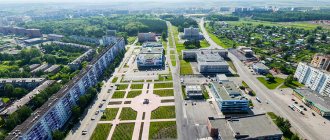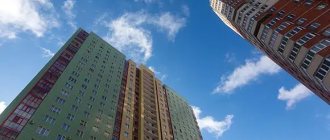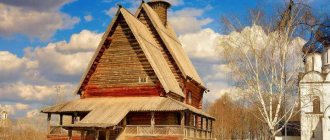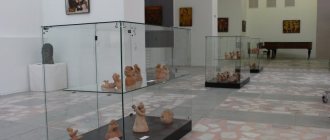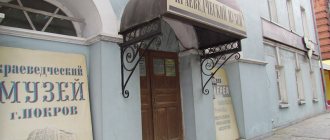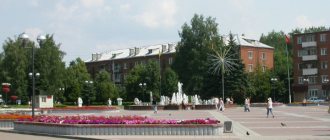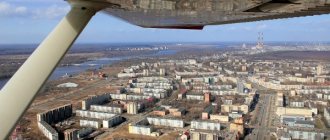The State Museum-Reserve "Pavlovsk" is the main attraction of the city of Pavlovsk near St. Petersburg. This palace and park ensemble was founded at the end of the 18th century and was completed until the beginning of the 20th century. Since 1990, the site has been included in the UNESCO World Heritage List.
Famous architects took part in the construction and design of the palace and park complex in Pavlovsk: initially the palace was built according to the design of Charles Cameron, further alterations and interior design were carried out by Andrei Voronikhin, Giacomo Quarenghi and Carl Rossi. The last large-scale restoration work was carried out in 1972.
Bird's eye view of the museum-reserve in Pavlovsk:
State Museum-Reserve "Pavlovsk"
The museum-reserve is the main attraction of Pavlovsk. This place was the imperial residence. The palace and park ensemble was built over 50 years, from the 18th to the early 19th centuries. Famous architects - Cameron, Brenna, Quarenghi, Voronikhin, Rossi, Gonzago and thousands of Russian masters created it for decades.
Great Pavlovsk Palace
Pavlovsk Palace is the center of the museum-reserve. It was built on the banks of the Slavyanka River, and you can see it even from the far corners of the city. The palace was built in the 80s of the 18th century by the famous architect Charles Cameron.
The idea of the palace came to Paul I during a trip to Europe in 1782. Inspired by the architecture of Austria, Italy, and France, he decided to build an equally magnificent palace. The imperial family purchased furniture, porcelain and silk in France, Venetian glass, copies of ancient sculptures and paintings in Italy. All items were brought to Pavlovsk to decorate the palace.
After Paul I ascended the throne, the residence was expanded: several floors and rooms were added. After his death, his son, Nicholas I, became the owner of the palace. He issued a decree on organizing a museum, the exhibits of which were relics brought by his parents.
Also, by order of Emperor Nicholas, a monument to Paul I was erected on the square in front of the palace. The Emperor is depicted looking at Linden Alley, where guests enter from. This monument is a copy of another statue of Paul I - the first one was installed in front of the Gatchina Palace.
Monument to Paul I in front of the Pavlovsk Palace
The refined and austere appearance of the Pavlovsk Palace contrasts with the splendor of its interior decoration. True, the original interiors created according to the designs of V. Brenna and G. Quarenghi no longer exist.
On January 10, 1803, for an unknown reason, a large fire broke out in the palace and raged for several hours. The central building was especially damaged by the fire, some of the halls in which were completely burned out.
The restoration of the palace was entrusted to the architect A. Voronikhin. In a short time - in less than two years - the Pavlovsk Palace was revived. And the formation of the Pavlovsk palace ensemble was completed in 1822-1824, when the architect K. Rossi built a library building.
Among the interiors of the palace, the Italian and Greek halls attract special attention.
The Italian hall, above which there is a skylight-dome, was designed by Charles Cameron, but was designed mainly by V. Brenna and later by A. Voronikhin. This room contains antique marble sculptures.
Italian hall
The Greek Hall, also created by V. Brenna and A. Voronikhin, got its name because it was decorated in an antique spirit: slender columns of greenish marble, antique statues in niches, lamps suspended on long chains between the columns.
Greek Hall
The Art Gallery created by V. Brenna is noteworthy. This hall is a tribute to the tradition of the 18th century, when such galleries were an obligatory part of Russian palaces. The Art Gallery contains paintings by Italian and Dutch masters.
The Great or Throne Hall is striking in its size - 400 square meters. It was originally created as a formal dining room, but later the imperial throne of Paul I was installed here.
Throne room
Currently, the palace houses a museum. Here guests can see:
- living rooms with household items from the 18th century, including the emperor’s wife with her personal belongings;
- memorial office of A.I. Zelenova - director of the palace from 1941 to 1979, she walked from Pavlovsk to St. Isaac's Cathedral to preserve exhibits during the blockade, after the war she made every effort to reconstruct the palace and not demolish it;
- Gonzago Gallery - an architectural and fresco ensemble of the 19th century, the largest example of outdoor fresco painting in Northern Europe;
- a costume museum with authentic clothes of the imperial family, including the outfits of Peter III, Catherine II, Paul I, his wife Maria Feodorovna and their children, as well as Alexandra Feodorovna, the last Russian empress;
- ceremonial and concert halls - a total of 28 rooms, including the throne room, the office of Paul I, the library, the orchestra and the palace church;
- open fund of Russian porcelain - a collection of porcelain products made in Russia in the 18th-19th centuries;
- the exhibition “Russian residential interior of the 19th – early 20th centuries”, which introduces visitors to living rooms in noble houses of the 19th century;
- exhibition “The World of a Woman and Her Hobbies”, dedicated not only to women of the 19th-20th centuries, but also to the life of the nobility.
In addition to exhibitions, the palace has a café, a restaurant and a souvenir shop.
Pavlovsk Palace
The palace greets everyone who enters the park through the central entrance. And thanks to its location on a hill, it can be seen from other parts of the park.
Shortly before the construction of the palace began, Emperor Paul and his wife went on a trip to Europe. From the trip they brought works of art that inspired the architects to create an unusual palace. It took 50 years to bring the idea to life. The result is a perfectly symmetrical palace, the facade of which is decorated with sculptures and stucco.
Inside is the Museum of Antiquities
with antique sculptures, paintings by Italian and Flemish masters and a collection of porcelain.
Pavlovsk Palace @warmth_of_family
Pavlovsky Park
This is a large area around the palace, with an area of about 600 hectares. It is divided into 7 parts:
- Palace - the area around the palace, with flower beds, a linden alley, a large staircase leading to the river, gazebos and several pavilions;
- The valley of the Slavyanka River is located along the shore, trees are planted here, there are several bridges and sculptures;
- Big Star with a Valley of Ponds - an area equipped for walks and carriages, with paths and numerous ponds, a music station (was destroyed in the Second World War), and a hall intended for dancing;
- Old Sylvia - an area planted with coniferous trees, with a monument to the parents of Maria Feodorovna, and a statue of Apollo, from which 12 roads leading to the pavilions diverge;
- New Silvia - a forest area with several sculptures and a mausoleum to the benefactor husband, which the emperor's wife ordered to be erected in his honor;
- Parade Field - originally created for military exercises and parades, but after the death of Paul I it was converted into a park with artificial ponds;
- White Birch is a forest with picturesque natural landscapes.
Among the famous objects of the park: the Temple of Friendship - the rotunda that Emperor Paul I gave to his mother, the Colonnade of Apollo, the Pink Pavilion - the favorite vacation spot of Maria Feodorovna, the emperor’s wife. There are also sculptures, a bridge over the river, and other interesting structures.
Temple of Friendship - rotunda in Pavlovsk
Colonnade of Apollo
Pink Pavilion
The park has more than 350 species of trees - larch, pine, fir, birch, linden, elm and others, as well as more than 80 species of shrubs, such as acacia and dogwood. More than 70 species of birds, squirrels, hares, stoats, hedgehogs and other animals, reptiles, and insects live here.
Address and how to get there
The State Museum-Reserve "Pavlovsk" is located at the address: Sadovaya Street, 20. At the entrance to the park there is a public transport stop "Palace", where buses No. 370, 372, 375A, 383, 493 stop.
Entrance fees
| An object | Adults | Students (under 18 years old) and pensioners |
| Pavlovsky Park | 100 rubles | 50 rubles |
| Castle | 500 rubles | 200 rubles |
| Exhibitions and exhibitions | 150 rubles | 100 rubles |
On weekends and holidays, admission to the park is free from 6:00 to 10:00, and from 17:00 to 21:00.
Schedule
The park is open daily from 6:00 to 21:00.
Palace - every day except Friday and the first Monday of the month, from 10:00 to 18:00.
Pavlovsk
Personally, I most often get to Pavlovsk by bus or minibus. They run from several metro stations in St. Petersburg (there are no direct flights from Moscow).
From the Moskovskaya metro station
Most routes start from Moskovskaya. This is where buses and minibuses to Pulkovo Airport come and go, so if you have a great desire to fly to St. Petersburg and immediately go to Pavlovsk, then this is not a problem.
The stop on Moskovskaya is located right behind the square with the fountain, next to the House of Soviets (this large building catches the eye, so it will be difficult to miss it).
You don’t really need to remember the bus numbers, since most often there is a sign on the windshield of the vehicle indicating the destination. If you see the word “Pavlovsk”, feel free to sit down. Well, for those who still like specifics, I will write the route numbers: No. 299, 545.
The journey will cost no more than 50 rubles. True, there is one drawback: already at Moskovskaya, and further along some sections of the route, there are often large traffic jams, so you should choose the time more carefully and avoid rush hours.
From Zvezdnaya metro station
You can also leave Zvezdnaya by bus No. 179. After exiting the metro, you will need to go to the opposite side of the street, where the Continent shopping complex is located. It's hard not to notice him. There is a stop right next to the Continent. The ticket price, as on regular city buses, is 40 rubles. For those who have a travel pass, this is the most ideal option.
From metro station "Kupchino"
From the Kupchino metro station there are minibuses No. 286, 521. And also No. 363, which also passes through Zvezdnaya. The fare is 46 rubles.
The stop is located on Vitebsky Prospekt. When exiting the metro, you should pay attention to the signs in the passage and follow where the above-mentioned street is indicated. Or simply navigate like this: on one side there will be an exit from the transition to Balkan Square to the shopping centers, if you go there, then you need to return and go straight to the stop, there will only be a wall and two stairs. Go up any one and you will immediately see a stop.
How to get from the station to the center of Pavlovsk
In Pavlovsk, all of the above buses and minibuses arrive at various stops scattered throughout the city. However, it is most convenient to get off at the one that is located near the train station (I wrote about the location in the section above).
The stop is hard to miss. But if you are not sure that you will be able to notice it, then do not be afraid to ask the driver or other passengers: on suburban routes there are often lively old women who will be happy to tell you in detail where the stop you need is located. And even pensioner(s) who seem gloomy at first glance are unlikely to be able to refuse if you ask them politely. Moreover, drivers most often simply forget while working who asked them what to do, unless you constantly remind them. 
Church of St. Mary Magdalene
The church, built in 1784, is the first stone building in the city. The foundation was laid in the presence of Emperor Paul I, and the sponsor of the construction of the Orthodox church was his wife, Maria Fedorovna. It was built in just 5 months, but was consecrated only 3 years after the completion of the work.
In 1932, the authorities closed the church, and the premises were used as a shoe factory, which operated until 1941. After the war, various industries were located here, the machines of which caused damage to the structure due to the vibrations they emitted. In 1995 it was returned to the Russian Orthodox Church.
Reconstruction was going on in the temple for several years; services were restored only in 2000. On the vaults of the church you can see paintings from the early 19th century. The temple preserves the vessels that Maria Fedorovna carved from ivory. In addition, among the church valuables are icons of the 18th century, which were a wedding gift to Paul I, military relics, monuments to the teachers of Paul I and Alexander I.
Address and opening hours of the Church of St. Magdalene
Sadovaya Street, 17. The church is open daily from 9:00 to 19:00.
Story
Pavlovsk is an outstanding palace and park ensemble of the late 18th and early 19th centuries, which was built as the summer residence of Emperor Paul I and his family. Pavlovsk Park is one of the largest in Europe, its area is 600 hectares.
The collection of the Pavlovsk Palace is associated with the travel of the imperial family across Europe in 1781–1782. Paintings, furniture, fabrics, porcelain sets, antique sculptures, and many gifts from the royal courts of Europe were brought.
Since its creation, Pavlovsk Park has been famous as the best landscape park in the world. The reason for the charm of the park is said to be the surprisingly accurate proportionality of the landscape and architectural structures found. Other researchers consider the key to success to be a successful choice of location for Pavlovsk Park - a hilly, but not contrasting landscape in the valley of the Slavyanka River. The numerous turns of this river and the different heights of the banks made it possible to so harmoniously combine strict and classic buildings and the surrounding nature.
Pavlovsk Palace was created by Charles Cameron in the 80s of the 18th century. After Paul I ascended the throne, Pavlovsk became a country imperial residence.
Cathedral of St. Nicholas the Wonderworker
The temple is one of the most recognizable landmarks of Pavlovsk. It was built at the beginning of the 20th century. Construction took 4 years due to lack of funds and unusually cold winters. In 1933, the cathedral was closed and the premises were used as a warehouse and repair shop. The building was heavily damaged during shelling and bombing during the Great Patriotic War. Reconstruction began only in 1991, and lasted for 10 years.
Currently, services are held in the cathedral, and in 2011 a monument to Nicholas II was erected nearby.
Address and work schedule
Artilleriyskaya Street, 2. The cathedral is open daily from 9:00 to 18:00.
Marienthal
Or its other name is Bip Castle. A small fortress with two towers and a park was built in 1797 by order of Paul I. The emperor wanted this castle to be “amusing”; it was built exclusively for entertainment events and receiving guests. Despite this, the fortress was listed as military, all because it was equipped with 28 artillery pieces.
After the death of the emperor, the building became the first school in the country for the deaf and dumb, then an infirmary, and then an educational institution. During wartime there was an orphanage and a military registration and enlistment office here. Unfortunately, the fortress was almost completely burned down during the Second World War.
For a long time these were abandoned ruins, and only in 2000 did reconstruction begin. Now the fortress building houses a hotel and restaurant.
Marienthal's address and working hours
Mariinskaya Street, 4. The restaurant is open daily from 12:00 to 22:00.
Other entertainment
Squirrels are an unofficial attraction of Pavlovsk Park. Of course, they can be found not only here. But it is believed that the animals in this park are especially trusting and tame. If you bring some nuts with you, you can feed the Pavlovian squirrels
from the palm of your hand.
In the summer, you can rent a bicycle or Segway in the park and ride past the main attractions. There are also boat rentals and a trampoline. In winter, many people come here to ski or sled. And, of course, don't forget to take your camera with you. Even if a photo shoot was not part of your plans, it is difficult to resist taking a few photos in Pavlovsky Park.
Squirrel in Pavlovsky Park @pupsalinochka
Train Station
The railway station in Pavlovsk is the terminus of the first railway in the Russian Empire, opened in 1838. Unfortunately, the original historical building was completely destroyed during the war, and only the lantern was saved.
The new station building was built in 1955 in the Stalinist Empire style. It was designed by the same architect who was involved in the reconstruction of the palace and park ensemble - E. A. Levinson. Attention should be paid to the rotunda in the central part. In 2016, the railway station building was recognized as a cultural heritage site.
Station address in Pavlovs: Station Square, 1.
Monument to composer Johann Strauss
This is a relatively young monument - it was opened in 2003. The famous composer first came to Russia on tour in 1856, and since then, for 10 years, Strauss conducted the Pavlovsk summer concerts. The orchestra under his leadership achieved the highest skill, which was noted by music critics.
The monument to the composer is a smaller copy of the sculpture installed in Vienna in 1907.
The monument is located near the entrance to Pavlovsky Park, in the park at the intersection of Sadovaya and Zverenitskaya streets.
Terraces and pavilions
If while walking around Peterhof you encounter statues and fountains at every step, then in Pavlovsk the encounter with beauty happens unexpectedly.
So, not far from the entrance to the park there is a Great Stone Staircase
with lions.
When creating it, the architect used a trick. Due to the fact that the staircase tapers at the top, it appears longer than it actually is. Once you reach the Slavyanka River, the concentration of monuments will increase. The Colonnade of Apollo
is located here . The attraction is located so that you can admire it from the windows of the palace. Cross Slavyanka on the Bridge of Centaurs. It is decorated with plaster casts of ancient sculptures.
In the Old Sylvia area you can find sculptures of the 12 muses
and a statue of Apollo. From each muse a path departs. One of them leads to the Ruin Cascade.
Colonnade. Photo: @pavlovsk_palace_and_park
Nicholas (Cast Iron) Gate
The majestic cast-iron gates were installed by order of Nicholas I. He presented them as a gift to his mother. They consist of 16 columns on pedestals. The gate is crowned by a double-headed eagle, with a crown on its head and a developing ribbon at its paws. During the Great Patriotic War, some of the decorations were lost, but restored in 1981.
The gate is located at the intersection of Sadovaya and Berezovaya streets.
Pavlovsk Amusing Fortress (Bip Fortress)
Address: Nadgornaya st., 16
The fortress was built near the Slavyanka and Tyzva rivers on the site of the Marienthal house. Architect Quadri built a pleasure castle in two years, but according to all the rules of military fortification.
That is why the building was registered with the military department for a long time. Every evening the drawbridge was raised in the fortress and a cannon was fired, this continued until 1917. After the death of Emperor Paul, the first school in Russia for deaf and mute children was established in the castle.
In 1919, Yudenich's headquarters was located here. During the Great Patriotic War, the fortress was almost completely destroyed and was a stone box.
The name BIP is interpreted in different ways, one of these interpretations is: “Paul’s Big Toy.”
At the beginning of this century it was restored. Now there is a hotel and restaurant here.
Obelisk of the founding day of the city of Pavlovsk
The obelisk, rising on a pedestal of stones, was installed in 1782. The author of the project was Charles Cameron, who was the main architect of the city. The inscription “Pavlovskoe began to be built in 1777” is engraved on the obelisk.
The obelisk was installed on the shore of the Marienthal Pond, in the territory of the Bip Fortress Park, across the road from the Pavlovsk Palace.
Museum of the History of Pavlovsk
This museum was opened in 2003, on the initiative of city residents. The small building contains several halls, each of which contains exhibits from different eras. Many of them are donated by local residents and collectors. Guests can see old photographs, documents, building models, household items and art, and children's toys.
The museum is located at Peschany Lane, 5/13. Doors are open from Sunday to Thursday, from 10:00 to 17:00, admission is free.

